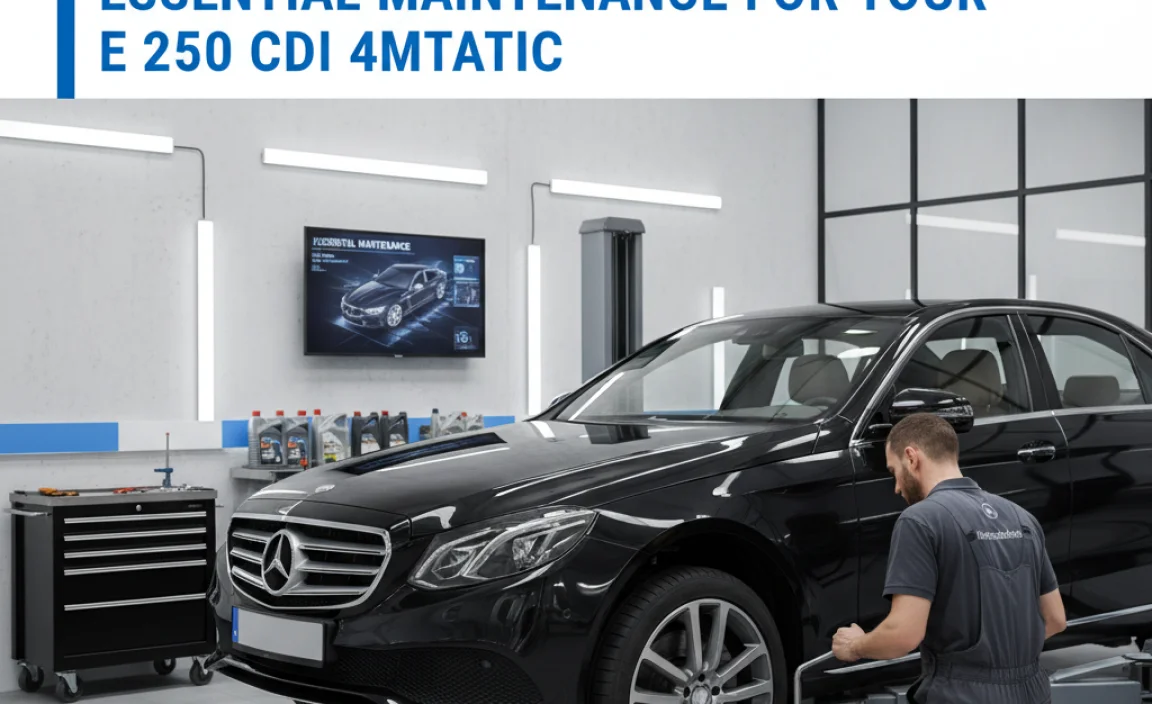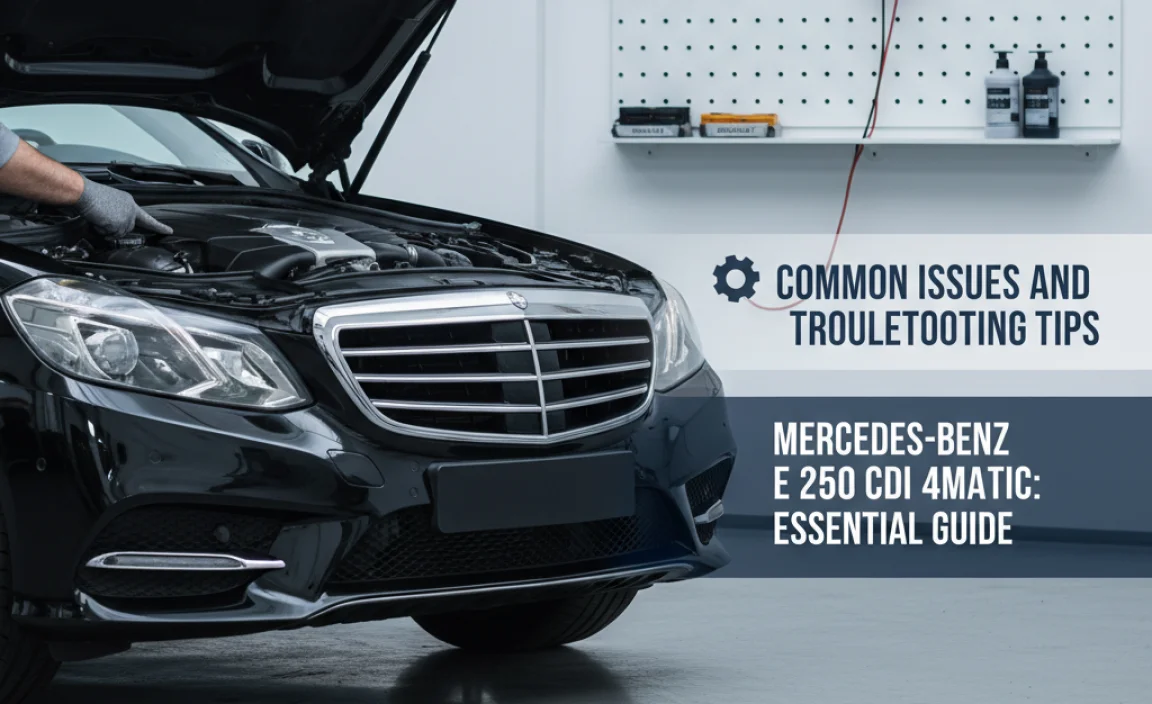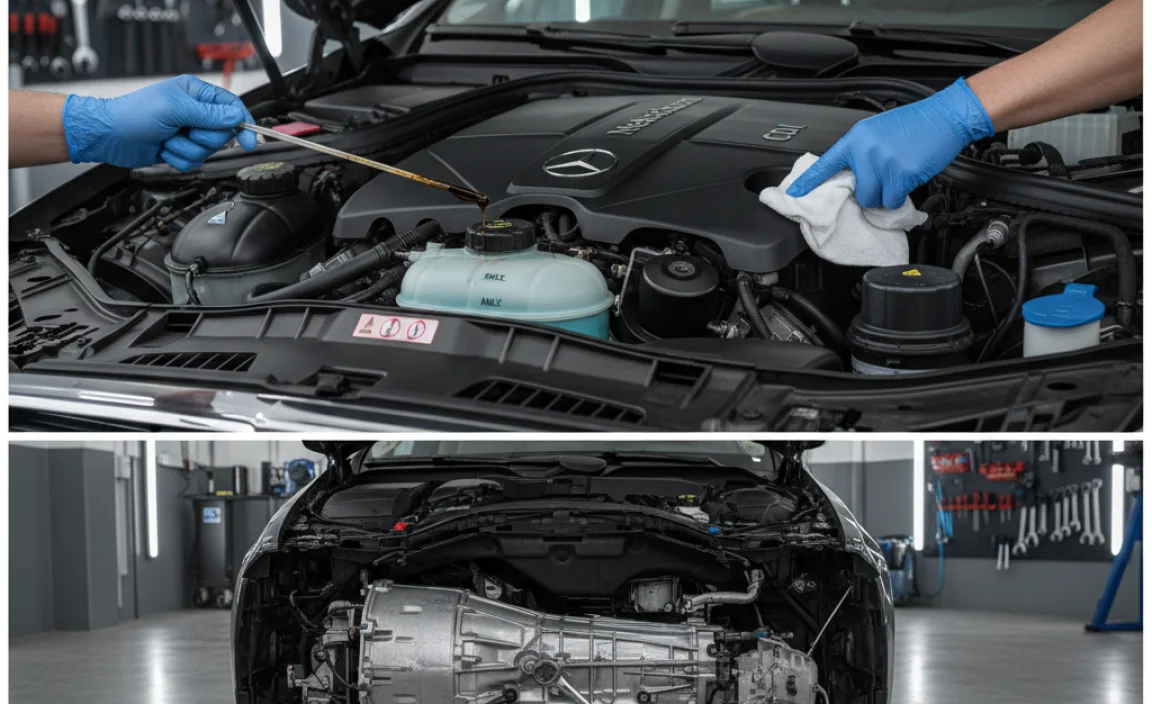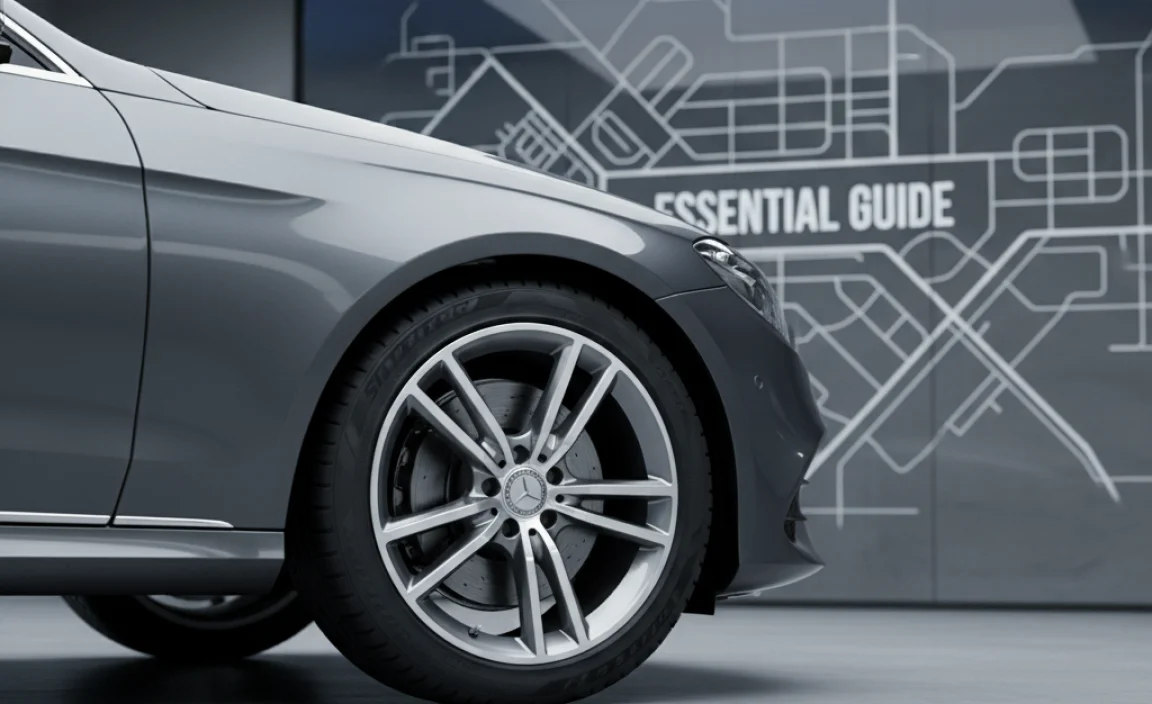The Mercedes-Benz E 250 CDI 4Matic is a sophisticated executive sedan offering a blend of performance, efficiency, and all-wheel-drive capability. This guide provides essential maintenance, troubleshooting, and ownership tips for owners, focusing on keeping your E 250 CDI running smoothly and reliably.
Welcome, fellow Mercedes-Benz enthusiasts! Owning a piece of German engineering excellence like the E 250 CDI 4Matic is a rewarding experience. These cars are built to last, but like any complex machine, they appreciate a little attention. Sometimes, understanding what your car needs, or how to tackle a simple issue, can feel a bit daunting. That’s where I come in. My goal is to break down car care into straightforward, manageable steps, so you feel confident taking on your Mercedes. We’ll cover everything from basic checks to understanding common quirks, all in a way that’s easy to grasp.
This guide is designed to be your go-to resource for keeping your E 250 CDI 4Matic in top condition. We’ll dive into what makes this model special and how to keep it performing at its best. Let’s get started on demystifying your Mercedes-Benz!
Understanding Your Mercedes-Benz E 250 CDI 4Matic

The Mercedes-Benz E 250 CDI 4Matic represents a sweet spot in the E-Class lineup, particularly for those who value robust performance and excellent fuel economy. The “CDI” designation signifies that this model is powered by a Common Rail Direct Injection diesel engine, known for its torque and efficiency. The “4Matic” part means it comes equipped with Mercedes-Benz’s renowned all-wheel-drive system, providing superior traction and stability in various driving conditions, from wet roads to light snow.
This combination makes the E 250 CDI 4Matic a fantastic all-rounder. It’s powerful enough for confident overtaking, economical enough for daily commuting, and safe enough for family trips, especially with the added certainty of 4Matic. Understanding its core components will help you appreciate its capabilities and know what to look out for.
The Diesel Advantage
Diesel engines, like the one in your E 250 CDI, have a reputation for durability and torque. They burn fuel more thoroughly than gasoline engines, leading to better fuel efficiency over longer distances. This means fewer stops at the pump and more miles on the road. The robust nature of diesel engines also means they can often go for longer periods between major services, provided they are well-maintained.
4Matic: All-Wheel Drive for Every Season
The 4Matic system is designed to actively manage power distribution between the front and rear axles. It works seamlessly in the background, enhancing grip and driving dynamics. Whether you’re navigating a rainy commute or heading to the slopes, 4Matic provides an extra layer of security and confidence. It’s a sophisticated system, but it generally requires no direct owner intervention beyond ensuring your tires are properly inflated and the tires themselves are suitable for the conditions you drive in.
Essential Maintenance for Your E 250 CDI 4Matic

Regular maintenance is the cornerstone of keeping any luxury vehicle, especially a Mercedes-Benz, in optimal condition. For the E 250 CDI 4Matic, adhering to the manufacturer’s service schedule is paramount. These schedules are designed by engineers who know the car inside and out, ensuring all components receive the necessary attention at the right intervals.
Don’t let the term “service schedule” intimidate you. It’s essentially a list of checks and replacements based on mileage or time. Many tasks are simple enough for a DIY enthusiast, while others require specialized tools or knowledge best left to a qualified technician.
Understanding the Service Intervals
Mercedes-Benz typically uses a service indicator system (often referred to as “Service A” and “Service B,” or similar designations depending on the model year and region) to remind you when maintenance is due. These indicators are more sophisticated than simple mileage counters; they consider driving style, actual usage, and time elapsed.
- Service A (Often minor service): Typically involves an oil and filter change, a tire rotation, and a general inspection of key fluid levels and safety components.
- Service B (Often major service): Includes everything in Service A, plus more in-depth checks like replacing the cabin air filter, brake fluid, and inspecting more components like the suspension and exhaust system.
Always consult your owner’s manual for the specific service intervals and requirements for your E 250 CDI 4Matic model year. If you’re unsure, your local Mercedes-Benz dealer or a trusted independent specialist can provide this information.
Key Maintenance Tasks You Can Do (or Supervise)
While some tasks are best left to the professionals, there are crucial checks you can perform regularly to stay on top of your car’s health:
- Check Engine Oil Level: This is a critical check. Diesel engines rely on clean oil for lubrication and cooling. Low oil levels can lead to significant engine damage. You can usually check this via the car’s digital display. Consult your owner’s manual for the exact procedure; it often involves letting the engine warm up and sitting idle for a minute before checking.
- Inspect Tire Pressure: Properly inflated tires improve fuel economy, handling, and tire life. Check your tire pressures at least monthly using a reliable tire pressure gauge. The recommended pressures are usually found on a sticker inside the driver’s side doorjamb.
- Check Wiper Blades and Washer Fluid: Good visibility is essential for safety. Ensure your wiper blades are in good condition (no streaks or skipping) and that your washer fluid reservoir is topped up, especially before winter.
- Inspect Lights: A quick walk-around to check all exterior lights (headlights, taillights, brake lights, turn signals) ensures you’re visible and compliant with traffic laws.
- Listen for Unusual Noises: Your ears are a great diagnostic tool. Listen for any new squeaks, rattles, knocks, or grinding sounds while driving. These can be early indicators of issues.
What Might Need Professional Attention
These are tasks that typically require specialized tools, diagnostic equipment, or the expertise of a trained technician:
- Engine Oil and Filter Change: While straightforward, ensuring the correct grade of oil and proper disposal.
- Brake Fluid Flush and Replacement: Essential for braking performance and safety.
- Coolant Level and Condition Check: Important for preventing engine overheating.
- Transmission Fluid Service: Usually required at specific mileage intervals.
- Diesel Particulate Filter (DPF) Regeneration/Checks: Diesel engines have specific systems to manage exhaust emissions.
- Software Updates: Mercedes-Benz vehicles have complex electronic systems that may require periodic software updates.
For these tasks, finding a reputable Mercedes-Benz specialist is highly recommended. They will have the correct parts, tools, and knowledge to service your specific model.
Common Issues and Troubleshooting Tips

Even well-engineered vehicles can encounter common issues. For the E 250 CDI 4Matic, understanding these potential problems can save you time and worry.
Diesel-Specific Concerns
Diesel engines have a few unique considerations:
- Glow Plugs: These are crucial for cold starts. If your car struggles to start in cold weather, glow plugs could be the culprit. The dashboard will usually present a warning light.
- Diesel Particulate Filter (DPF): The DPF traps soot from the exhaust. If the car is primarily used for short journeys, it might not get hot enough to burn off the soot. This can lead to the DPF becoming blocked, triggering a warning light. Sometimes, a longer drive at highway speeds (consistent RPMs for at least 20-30 minutes) can force a regeneration cycle. If the warning persists, professional intervention might be needed. You can find more information on DPF systems from reputable automotive engineering resources like those from SAE International.
- AdBlue (DEF) System: Some diesel models use AdBlue (Diesel Exhaust Fluid) to reduce emissions. If your AdBlue tank is low or empty, the car may refuse to restart after being turned off. Ensure you use the correct AdBlue fluid from a known supplier.
Electrical Gremlins
Modern Mercedes-Benz vehicles are packed with electronics. Occasional glitches can occur:
- Infotainment System Issues: Freezing, unresponsiveness, or connectivity problems can sometimes be resolved by a simple system reset. Consult your manual for the correct procedure.
- Sensor Malfunctions: Various sensors monitor engine performance, safety systems, and comfort features. A faulty sensor can trigger dashboard warning lights. Diagnosis often requires specialized scanning tools.
Suspension and Steering Noises
Over time, suspension components can wear. Listening for clunks, rattles, or creaks over bumps is important. Common culprits include worn bushings, ball joints, or shock absorbers. Addressing these promptly ensures a smooth and safe ride.
If you notice any of these issues, it’s best to get them checked by a qualified technician. They can accurately diagnose the problem and recommend the appropriate repair.
Fluid Checks: A Deeper Dive

Beyond engine oil, several other fluids are vital to your E 250 CDI 4Matic’s operation. While topping up is sometimes possible, checking levels and condition is a key part of preventative maintenance.
Engine Oil
- Type: Always use the Mercedes-Benz approved oil for your specific engine. This is usually a synthetic oil meeting certain ACEA or MB specifications. Using the wrong oil can damage the engine and void your warranty.
- Frequency: As indicated by your car’s service reminder system, typically every 10,000-15,000 miles or annually, whichever comes first.
- Checking: Most modern cars have an electronic oil level check via the dashboard. Consult your owner’s manual.
Coolant (Antifreeze)
- Purpose: Prevents the engine from overheating in summer and freezing in winter.
- Checking: Check the level in the expansion tank when the engine is cold. The level should be between the minimum and maximum marks. The color of the coolant is also important.
- Replacement: Mercedes-Benz specifies a particular type of coolant (often a blue or pink silicate-free formula). This should be flushed and replaced according to the service schedule.
Brake Fluid
- Importance: Essential for the hydraulic system that makes your brakes work. It absorbs moisture over time, which can reduce its effectiveness and cause corrosion.
- Checking: The fluid level in the reservoir should be between the min and max lines.
- Replacement: Typically recommended every two years, regardless of mileage. This is a critical safety component.
Power Steering Fluid (if applicable)
While many modern Mercedes-Benz vehicles have electric power steering, some earlier models might have hydraulic systems. If yours does, check the fluid level according to the owner’s manual. Low fluid can cause steering to become stiff or noisy.
Washer Fluid
Simple but crucial for visibility. Keep it topped up with a good quality washer fluid, perhaps with a de-icer in winter. Never just use plain water, as it can freeze or leave streaks.
Tires and Wheels: Keeping You Connected to the Road

Your tires are the only contact your car has with the road. For a powerful, all-wheel-drive vehicle like the E 250 CDI 4Matic, maintaining them is paramount for safety, performance, and comfort.
Tire Pressure Monitoring System (TPMS)
Your E 250 CDI 4Matic is equipped with a TPMS that alerts you if tire pressure drops significantly. However, this system is a warning, not a substitute for regular manual checks. It’s best to check your tire pressures manually at least once a month.
Optimal Tire Pressure
The correct tire pressure for your vehicle can be found on a sticker located on the driver’s side doorjamb or in your owner’s manual. It’s crucial to check pressures when the tires are cold.
Incorrect tire pressure can lead to:
- Uneven tire wear
- Reduced fuel efficiency
- Compromised handling and braking
- Increased risk of tire damage or blowouts
Tire Rotation and Balancing
Tire Rotation: Regularly rotating your tires (usually every 5,000-7,500 miles, or as part of your scheduled servicing) helps ensure they wear evenly. This prolongs their life and maintains consistent handling. The 4Matic system benefits greatly from even tire wear across all four wheels.
Wheel Balancing: If you notice vibrations through the steering wheel or the car at certain speeds, your wheels might be out of balance. This is usually addressed during tire rotation or when new tires are fitted.
Choosing the Right Tires
When it’s time for new tires, consider the type of driving you do. For an E 250 CDI 4Matic, you’ll likely want a good quality set of ”’premium touring”’ or ”’grand touring”’ tires. If you frequently encounter snow, all-season or winter tires are a wise investment, especially in conjunction with 4Matic. Always ensure the tires you choose meet the load and speed ratings specified by Mercedes-Benz for your vehicle.
Understanding Your Dashboard Warning Lights
The instrument cluster in your E 250 CDI 4Matic is designed to inform you about the car’s status. While some lights are routine (like turn signals), others indicate a problem that needs attention. Here’s a look at some common ones:
| Light Symbol | Meaning | Action |
|---|---|---|
| Brake System Warning | Check brake fluid level. If level is okay, and light persists, do not drive and seek immediate professional inspection. | |
| Glow Plug Indicator (Diesel) | Illuminates when the engine is cold; wait for it to turn off before starting. If it flashes, there’s an issue with the glow plug system. | |
| Check Engine Light | Can indicate a wide range of issues, from a loose gas cap to serious engine problems. Get it diagnosed promptly. | |
| Battery/Charging System Warning | Indicates a problem with the alternator or battery. If it illuminates while driving, try to get to a safe place and have it checked. | |
| Tire Pressure Monitoring System (TPMS) | One or more tires are significantly underinflated. Check and adjust tire pressures. | |
| Diesel Particulate Filter (DPF) Warning | The DPF is becoming clogged. Drive at a consistent highway speed for 20-30 minutes to attempt regeneration. If it persists, seek professional service. |
Note: Icon images are placeholders. Actual dashboard symbols may vary. Always refer to your owner’s manual for precise meanings and actions.
The color of the warning light is also important: red typically indicates a critical issue requiring immediate attention, while yellow or orange lights usually signal a problem that needs to be addressed soon but isn’t an emergency.
Frequently Asked Questions (FAQ)
Q1: How often should I service my Mercedes-Benz E 250 CDI 4Matic?
A: Your car’s onboard service indicator system will tell you precisely when maintenance is due. Generally, this is every 10,000 to 15,000 miles or once a year, whichever comes first. Always refer to your owner’s manual for the specific schedule.
Q2: Can I use regular diesel fuel in my E 250 CDI 4Matic?
A: Your E 250 CDI 4Matic is designed for high-quality diesel fuel. Using premium diesel fuel can sometimes offer benefits like cleaner combustion and potential DPF health improvements. Avoid any fuel that is not specifically classified as diesel.